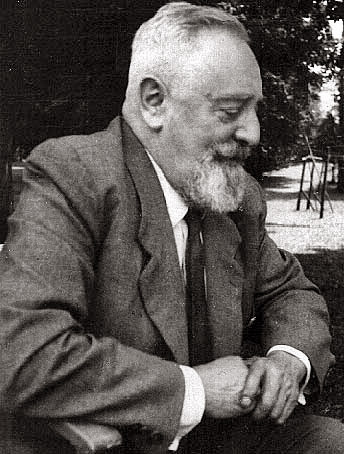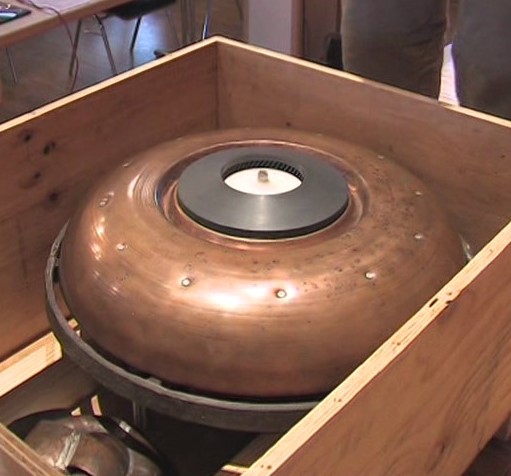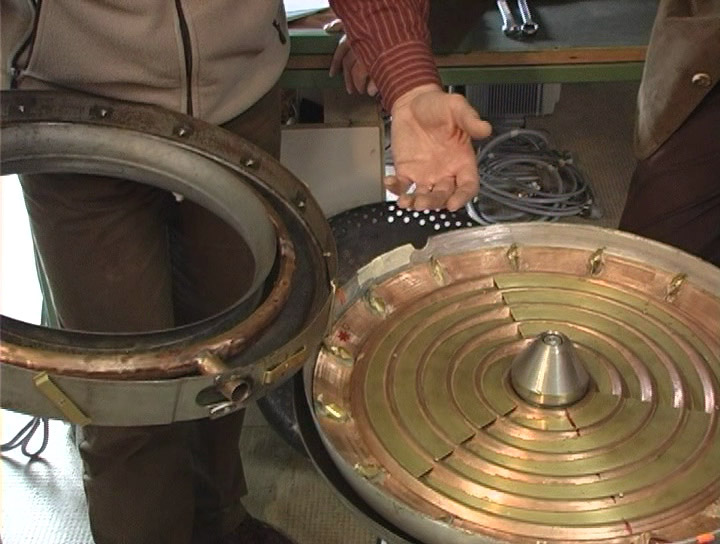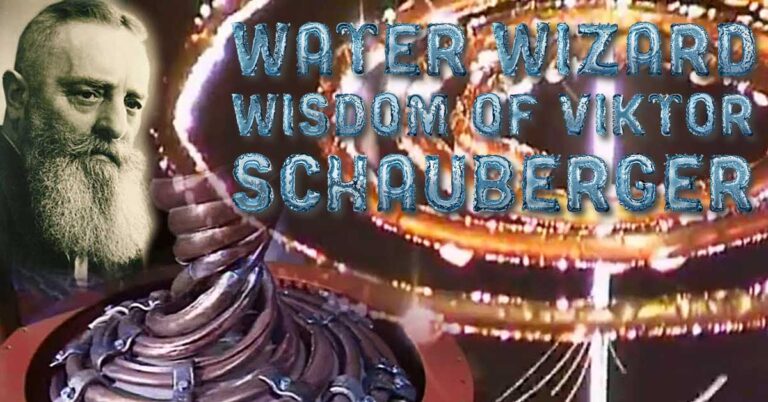Table of Contents
Introduction

Viktor Schauberger, born on June 30th, 1885, in Holzschlag, Austria, wasn’t just an Austrian forest caretaker; he was a brilliant inventor, naturalist, philosopher, and biomimicry experimenter. As the fifth of nine children in his family, Schauberger’s innovative ideas and groundbreaking inventions have left an enduring impact across various fields. What sets him apart is his unique approach, drawing inspiration directly from nature. Rather than following conventional paths, he developed his own ideas by keenly observing the natural world around him. This unconventional perspective made him not only an inventor but also a perpetual student of the intricate workings of nature. Even today, Schauberger’s legacy continues to captivate scientists, engineers, and nature enthusiasts, reminding us of the power of innovative thinking and the profound lessons that nature can impart.
1. Repulsine Technology: Unleashing the Power of Vortex Energy
He believed that by creating a vortex of air or other fluid in a closed system. Repulsine used an implosion-based propulsion system that Schauberger believed could achieve anti-gravity effects. He believed that by creating a vortex of air or other fluid in a closed system, it would be possible to generate a powerful inward-sucking force that could be harnessed for propulsion. Some conspiracy theorists and UFO enthusiasts have claimed that Schauberger’s work on the Repulsine was part of a secret German program to develop advanced aircraft or spacecraft using anti-gravity technology, but there is no credible evidence to support these claims

Design of the Repulsine
The Repulsine was a flying saucer-shaped aircraft that utilized a series of rotating disks to create a vortex that would lift the aircraft off the ground. The disks were said to be made of a special metal alloy that was capable of withstanding high temperatures and pressures. The aircraft was also said to be equipped with a series of propulsion jets that could be used to control its movement and speed.

Development of Repulsine Technology
The Repulsine was an experimental aircraft that Schauberger designed for the German military during World War II. The aircraft was designed to use implosion technology to create lift and propulsion, and it was said to be capable of reaching speeds of up to 2,000 km/h. Schauberger believed that by creating a vortex of air or other fluid in a closed system, it would be possible to generate a powerful inward-sucking force that could be harnessed for propulsion.
Schauberger reportedly worked on several prototypes of the Repulsine during the war, but there is no concrete evidence to confirm this. Some conspiracy theorists and UFO enthusiasts have claimed that Schauberger’s work on the Repulsine was part of a secret German program to develop advanced aircraft or spacecraft.
Controversy Surrounding Repulsine Technology
The Repulsine is a controversial invention, and there is little evidence to support Schauberger’s claims about the aircraft. Some researchers believe that the Repulsine was a hoax, while others believe that it was a real invention that was co-opted by the Nazi regime for military purposes. Schauberger’s involvement with the Nazi regime has been a subject of controversy, and it is unclear to what extent he supported the regime’s ideology and actions.
Summary
Viktor Schauberger’s Repulsine is a hypothetical flying saucer-shaped aircraft that he claimed to have developed during World War II. The design of the Repulsine utilized a series of rotating disks to create a vortex that would lift the aircraft off the ground, and it was said to be equipped with a series of propulsion jets that could be used to control its movement and speed. The Repulsine is a controversial invention, and there is little evidence to support Schauberger’s claims about the aircraft.
2. Trout Turbine – Harnessing Energy from Rivers
The trout turbine is a type of hydroelectric turbine that generates power using the natural flow of water. It imitates the natural movement of trout swimming upstream. Here are some key features of the trout turbine:
Observation of Trout Behavior
During his early years in the forest, Schauberger became fascinated with the sight of large trout and salmon lying nearly motionless in a stream while facing into a swift current. When he moved and startled the fish, they darted upstream headlong into the rushing current. He observed that the fish were able to swim upstream with minimal effort by using the natural vortex motion of water.
Design of the Trout Turbine
The design of the trout turbine was based on his observation of the natural vortex motion of water. The trout turbine utilized a spiral channel to create a vortex that would spin a turbine, mimicking the motion of water in a natural stream. Unlike conventional hydroelectric power plants, which use “explosive” destructive motion that drops pressure water and chops it through turbines, Schauberger’s trout turbine invigorated water and created clean, healthy water. The turbine is designed to work with a minimum drop height of two meters and requires a flow of at least 200 liters of water per minute.
Impact of the Trout Turbine
The trout turbine was one of Schauberger’s most notable inventions and had a significant impact on the field of hydroelectric power generation. The design of the trout turbine increased the efficiency of power generation by reducing turbulence in the water and minimizing damage to aquatic life. The trout turbine was also an early example of biomimicry, which is the practice of emulating nature’s designs and processes to solve human problems.
Summary
Viktor Schauberger’s trout turbine was a hydroelectric power generator that imitated the natural movement of trout swimming upstream. The design of the turbine increased the efficiency of power generation by reducing turbulence in the water and minimizing damage to aquatic life. The trout turbine was an early example of biomimicry and had a significant impact on the field of hydroelectric power generation.
3. Suction Turbine
Viktor Schauberger’s Suction Turbine is a pioneering hydropower device designed to revolutionize the field of renewable energy.
Design of the Suction Turbine
The suction turbine was a unique turbine that used implosion principles to produce electrical power. The turbine utilized air or water to create the force, and it was designed to work in harmony with the natural flow of water. The suction turbine was based on Schauberger’s observation of the natural vortex motion of water, and it utilized the natural implosion motion of water to generate power.
Principle of Operation
The principle of the suction turbine was based on implosion principles, which are the opposite of explosion principles. The turbine utilized the natural implosion motion of water to generate power, which was a more efficient and less damaging method than conventional hydroelectric power generation. The turbine created a vortex that would spin a turbine, generating electricity.
Impact of the Suction Turbine
The suction turbine was one of Schauberger’s most notable inventions and had a significant impact on the field of hydroelectric power generation. The turbine was highly efficient and environmentally friendly, making it a popular choice for small-scale hydroelectric power generation. The suction turbine was not suitable for large-scale power generation, as it was not as efficient as conventional hydroelectric power plants.
Legacy
Schauberger’s inventions, including the suction turbine, had a significant impact on society and inspired modern-day innovations and technologies, such as biomimicry and sustainable energy production. The suction turbine was an early example of biomimicry, which is the practice of emulating nature’s designs and processes to solve human problems.
Summary
Viktor Schauberger’s suction turbine was a unique hydroelectric power generator that used implosion principles to produce electrical power. The turbine utilized the natural implosion motion of water to generate power, which was a more efficient and less damaging method than conventional hydroelectric power generation. The suction turbine was highly efficient and environmentally friendly, making it a popular choice for small-scale hydroelectric power generation. Schauberger’s inventions, including the suction turbine, had a significant impact on society and inspired modern-day innovations and technologies.
4. Log Flumes – Efficient Transportation of Timber
Recognizing the importance of preserving forests and minimizing environmental damage during timber transportation, Schauberger invented log flumes. These specialized channels used the natural flow of water to transport logs, reducing the need for conventional methods that involved heavy machinery and caused soil erosion. Here is an explanation of Viktor Schauberger’s log flumes:
Efficient Design
Schauberger’s log flumes were designed to be highly efficient, using the natural flow of water to transport logs downstream. The design of the flumes was based on the principle of vortex motion. The log flumes were designed to minimize friction and turbulence, which allowed the logs to move downstream more quickly and efficiently.
He built a total of 14, not just in Austria, but also in Bulgaria, Bosnia, and Czechoslovakia. Schauberger’s log flumes were said to be highly efficient and effective, as they used the natural movement of water to float each log on a cup full of water, reducing logging costs to one-third of their previous cost
Operations
Schauberger introduced different temperatures of water into the log flume to generate the right energies. The colder water was positioned at the center, surrounded by water with less density and higher temperature. This arrangement facilitated a laminar flow and enabled the logs to be suspended and guided in the center of the dense water column.
Schauberger’s log flume employed alternating vertical flows and swaying movements, allowing the water to regenerate and cool itself. The temperature of the water affected its flow rate, with increasing heat slowing down the water’s movement.
Summary
Overall, his work on log flumes was part of his broader interest in natural movements and their potential applications in energy production and water enhancement. The flumes were designed to be highly efficient, using the natural flow of water to transport logs downstream. The design principles of the log flumes have had a lasting impact on modern technology and engineering.
5. Water Enhancement
Water Wizard: Viktor Schauberger made several contributions to water enhancement, including the development of implosion technology, vortex technology, and a water turbine that harnessed the vortices and spirals of water to generate energy. His work was based on his understanding of the natural properties of water, and it has inspired scientists, environmentalists, and water conservationists today as we strive to better understand and protect this vital resource for future generations.He also believed that the structure of water is vital to its health-giving properties.
Benefits of Water Enhancement
Water enhancement has several benefits, including better body hydration, improved immunity, and the elimination of toxic metabolic wastes. Water enhancement can also help to protect and preserve the environment by reducing the need for non-renewable energy sources.
Here are some key principles associated with Schauberger’s water enhancement concepts:
Implosion and Vortex Motion
Schauberger believed that water moves in a spiral or vortex pattern in nature, and this motion is vital for its energy and health. He emphasized the importance of encouraging implosion (inward movement) rather than explosion (outward movement) in water systems.
Structuring and Revitalization
Schauberger proposed that by recreating the natural spiral flow and imparting specific movements to water, its structure and vitality could be improved. He suggested that structured water, which mimics the characteristics of healthy flowing streams, could have various beneficial effects.
Temperature and Oxygenation
Schauberger recognized the significance of temperature and oxygen levels in water. He believed that maintaining a proper balance of temperature and oxygenation could enhance the vitality and health of water.
Materials and Design
Schauberger experimented with different materials, shapes, and designs to optimize water’s natural flow. He explored features such as conical shapes, helical pipes, and specific materials to create conditions that support the desired flow patterns.
Official Viktor Schauberger Video on YouTube
Enough with the Time-Wasting Swipes! Immerse Yourself in the World of Fascinating Discoveries. Watch this Official Unveiling of Viktor Schauberger and his Mind-Blowing Achievements. It’s Time to Channel Your Internet Usage Towards Meaningful Information!”
The first film about Viktor Schauberger’s life’s work was published some years ago on DVD.
A comprehensive survey of historical facts, current research and various practical applications into both technology and the natural world.
Conclusion
Viktor Schauberger wasn’t your typical inventor. He didn’t conquer nature; he learned from it. His inventions, inspired by fish, water, and air, weren’t machines; they were collaborations with the natural world. Today, scientists, engineers, and even you and me are taking cues from his playbook, building a future where technology dances with nature, not fights it. Let’s harness nature’s wisdom, not just its resources, and create a planet that thrives for generations to come. That’s Schauberger’s true legacy: a world where human ingenuity and nature’s magic high-five, not clash.



